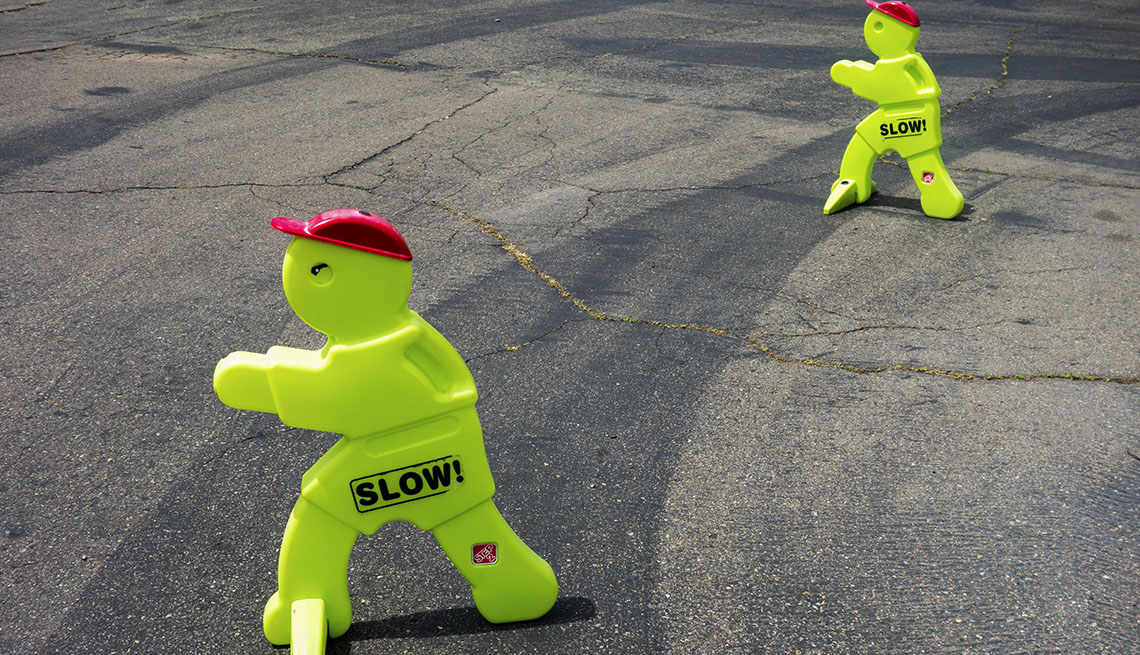
- Select a language for the TTS:
- UK English Female
- UK English Male
- US English Female
- US English Male
- Australian Female
- Australian Male
- Language selected: (auto detect) - EN
Play all audios:
New York Mayor Bill de Blasio and Police Chief William Bratton agree, which is why they are using the innovative program to eliminate all traffic deaths (pedestrian, bicyclist and motorist)
in a city where being struck by a car is now the leading cause of death for children under 14 and the second leading cause of death for older people. "The fundamental message of Vision
Zero is that death and injury on city streets is not acceptable, and that we will no longer regard serious crashes as inevitable," De Blasio wrote in a letter to New Yorkers. Vision
Zero, was enacted in New York City in 2014 with new laws that bolstered enforcement against speeding, dangerous driving and the failure to yield to pedestrians. The laws also lowered speed
limits, installed speed cameras, taught street safety in schools and reconstructed several roads for greater safety. The results could be seen immediately. "In 2014 we had an historic
low for pedestrian fatalities," declared Paul Steely White, director of the local walking advocacy organization Transportation Alternatives. "If we can do that here in New York, it
can be done anywhere." SAFER STREETS COAST-TO-COAST San Francisco, too, is aiming to end all traffic-related deaths over the next 10 years. That city's plan works on five fronts:
enforcement, education, engineering, evaluation and policy, says Tim Papandreou, director of strategic planning and policy for the San Francisco Municipal Transportation Agency. A major
focus is to fix the six percent of streets where 60 percent of all pedestrian and bicycle deaths and serious injuries occur. "A KEY ISSUE FOR OLDER PEOPLE IS HAVING ENOUGH TIME TO CROSS
THE STREET — THEY SHOULDN'T HAVE TO RUN TO MAKE IT SAFELY." _— Tyler Frisbee, policy director of the San Francisco Bicycle Coalition_ "A key issue for older people is having
enough time to cross the street — they shouldn't have to run to make it safely," says Tyler Frisbee, policy director of the San Francisco Bicycle Coalition, which helped lead the
campaign to enact Vision Zero. "The older population is changing. They want to walk and bike and be out more, so we have to change how we design our cities." The Vision Zero idea
is spreading. In April 2015 eight cities with campaigns underway (New York, San Francisco, San Diego, San Jose, Boston, Seattle, Portland and Washington, D.C.) formed the Vision Zero Network
to promote the idea nationally and learn from one another. Communities from Fort Lauderdale to Pittsburgh to San Mateo, California, are now preparing Vision Zero efforts, says Leah Shahum,
director of the new organization. Southern California is emerging as something of a hotbed for the movement, she explains, with Santa Ana, Long Beach, Los Angeles and San Diego all aspiring
to cut traffic deaths to zero. "That's big news in a place so associated with car culture," says Shahum. "WHO ARE THE MOST COMMON VICTIMS OF TRAFFIC VIOLENCE? OLDER
PEOPLE, YOUNGER PEOPLE, PEOPLE OF COLOR AND DISADVANTAGED COMMUNITIES." _— Leah Shahum, director, Vision Zero Network_ A key priority for all Vision Zero cities is protecting the most
vulnerable. "Who are the most common victims of traffic violence?" Shahum asks and then answers. "Older people, younger people, people of color and disadvantaged communities.
Helping these people will mean safer streets for everyone who drives, walks or bikes." STARTLING SUCCESS IN SWEDEN Vision Zero efforts in the U.S. borrow ideas that have been proven to
work in the Netherlands, Germany, the U.K. and, especially, Sweden, which enjoys the safest streets in the world. The death rate for Swedish motorists has been cut in half since 2000, and
pedestrian fatalities have declined 50 percent since 2009. _The Economist_ studied Sweden's startling success and identified these actions as critical: lowering speed limits, making
crosswalks more visible, narrowing street widths, creating pedestrian streets and erecting barriers to separate cars from walkers and bicyclists. "WE CAN'T WAIT TO DO THIS
GRADUALLY. WE CAN'T TELL A WHOLE GENERATION THAT WE'RE WORKING ON IT BUT IT WILL TAKE A FEW DECADES. YOU WON’T BE ABLE TO AGE IN PLACE. YOU’LL HAVE TO LIVE IN FEAR. BUT THINGS WILL
BE GREAT WHEN YOUR KIDS GET OLDER." _— Gil Penalosa, founder, 8 80 Cities_ A basic principle of Swedish road design is that it's more important to ensure everyone's safety
than to facilitate drivers' speeds. This differs from the view that prevailed in the U.S. for much of the past century. "For years the message that bicyclists and pedestrians heard
has been: 'You are responsible for your own safety,'" notes Secretary Foxx who, as mayor of Charlotte, North Carolina, was struck by a car while bicycling. "Walk at your
own risk. Bike at your own risk." As the nation's transportation secretary, Foxx has set out to make America's streets safe for all in his "Action Plan on Bike and
Pedestrian Safety," which proposes many of the same traffic improvements as the Vision Zero activists do. A WINNING POLITICAL ISSUE Gil Penalosa believes that safer streets can become a
winning issue for politicians of all political stripes. "Boomers want to feel safe on the streets, and they vote. People 55 to 65 have the highest rate of voting, then people 65 to 75
followed by people ages 45 to 55. They have the time and the energy and the clarity to work on issues like these, which are good for everyone." Still, Penalosa worries that many
politicians lack a sense of urgency about the problems. "We need to push them," he declares. "We're talking about people's lives and freedom to move. We can't
wait to do this gradually. We can't tell a whole generation of people that we're working on it but it will take a few decades. _You_ won’t be able to age in place. You’ll have to
live in fear. But things will be great when your kids get older." _Jay Walljasper is a writer, speaker and consultant on making our communities great places for everyone and author of
The Great Neighborhood Book. _ _Page published October 2015_ RELATED: More from AARP.org/Livable Use the dropdown to choose a livability topic. Select a Subject
![[withdrawn] near miss with a track worker at llandegai tunnel](https://assets.publishing.service.gov.uk/media/6051d710d3bf7f0455a6e604/s960_Llandegai_tunnel.jpg)






